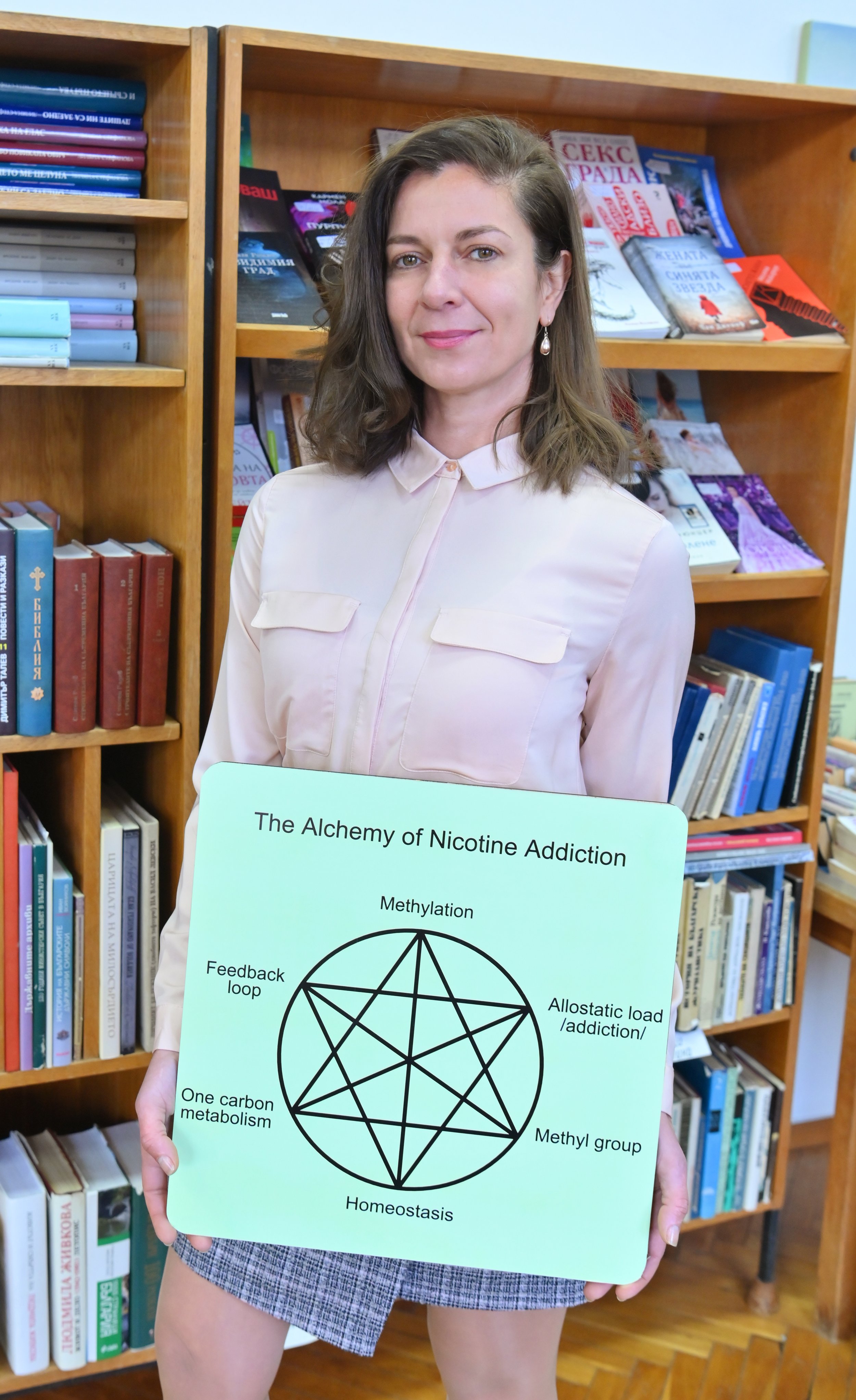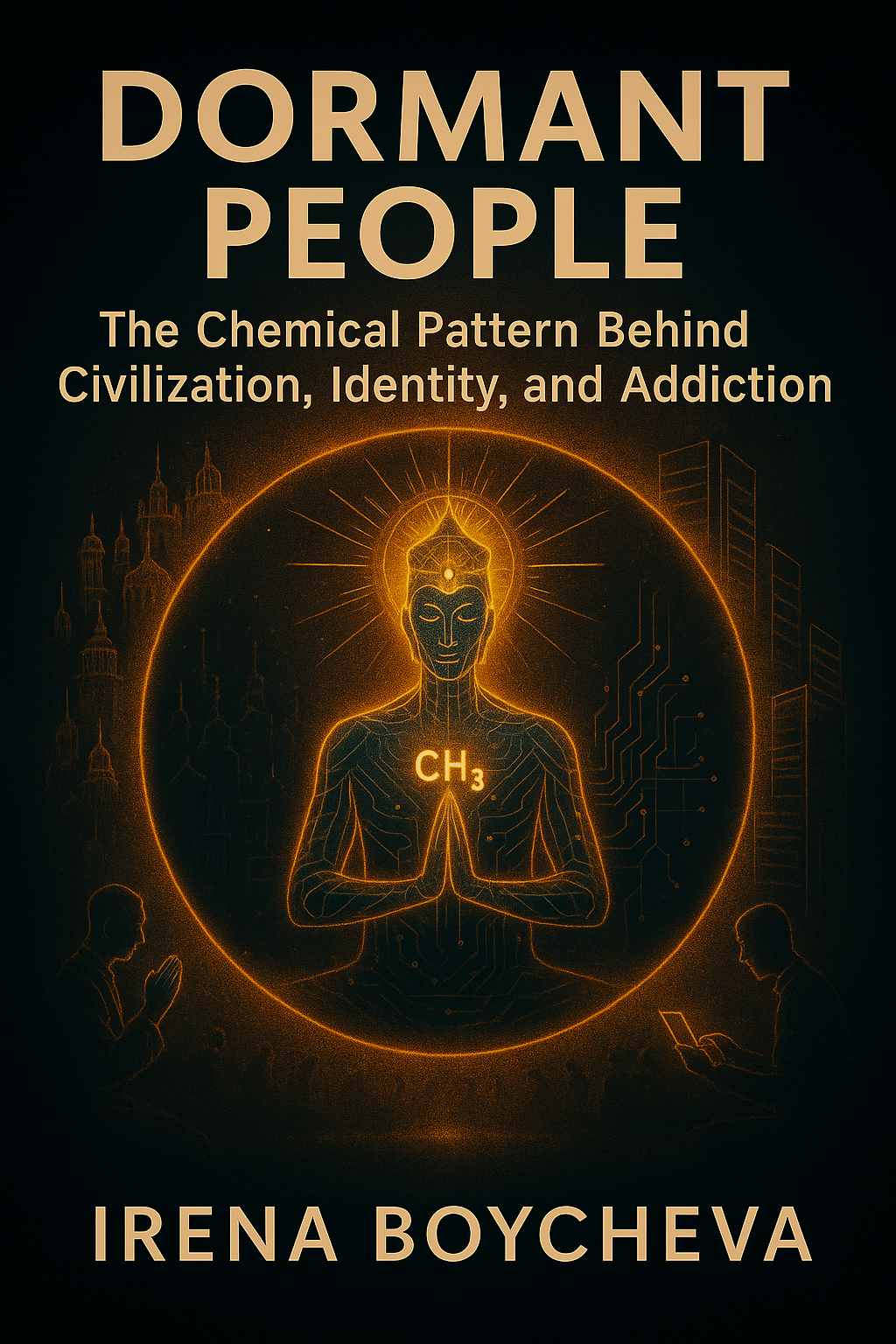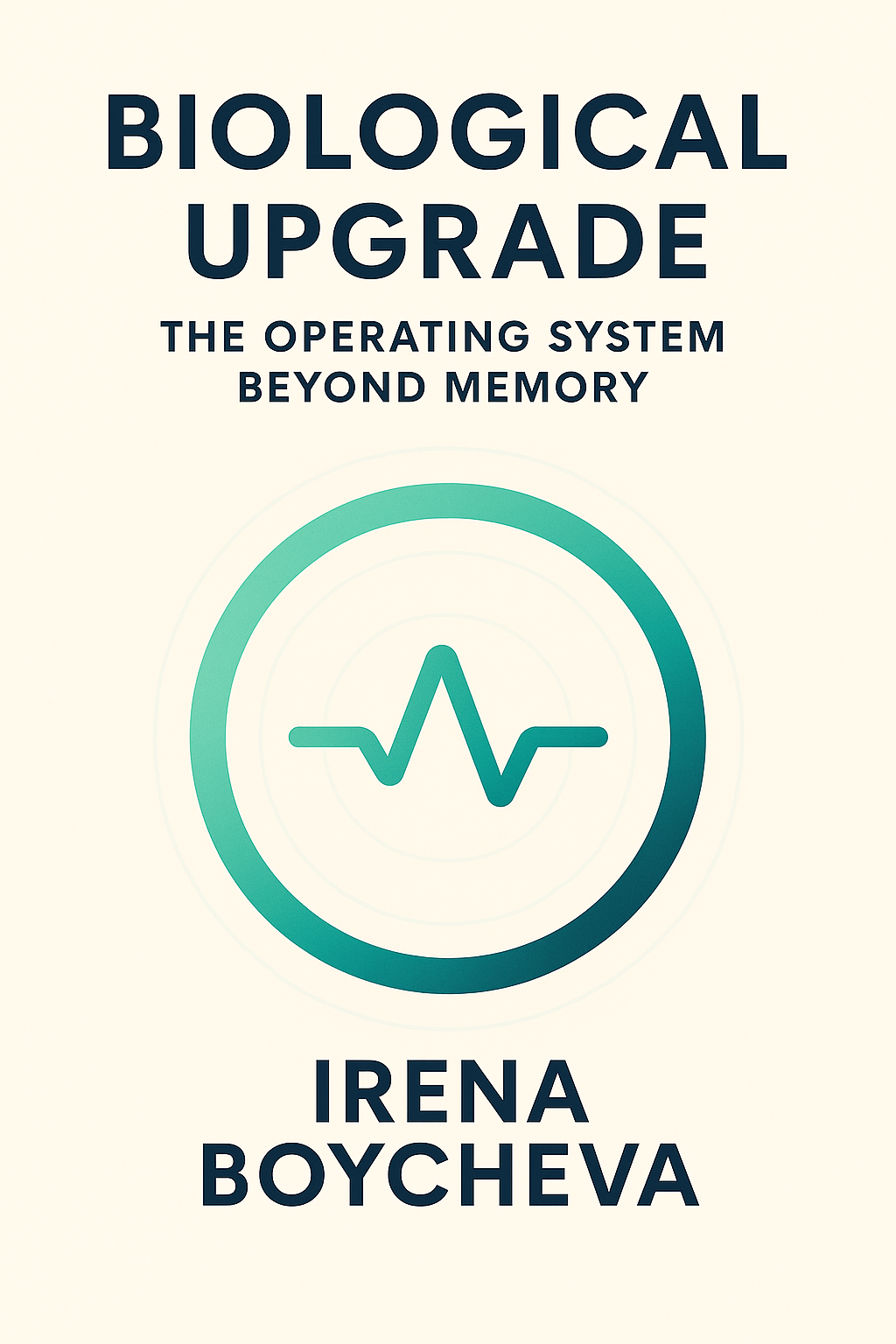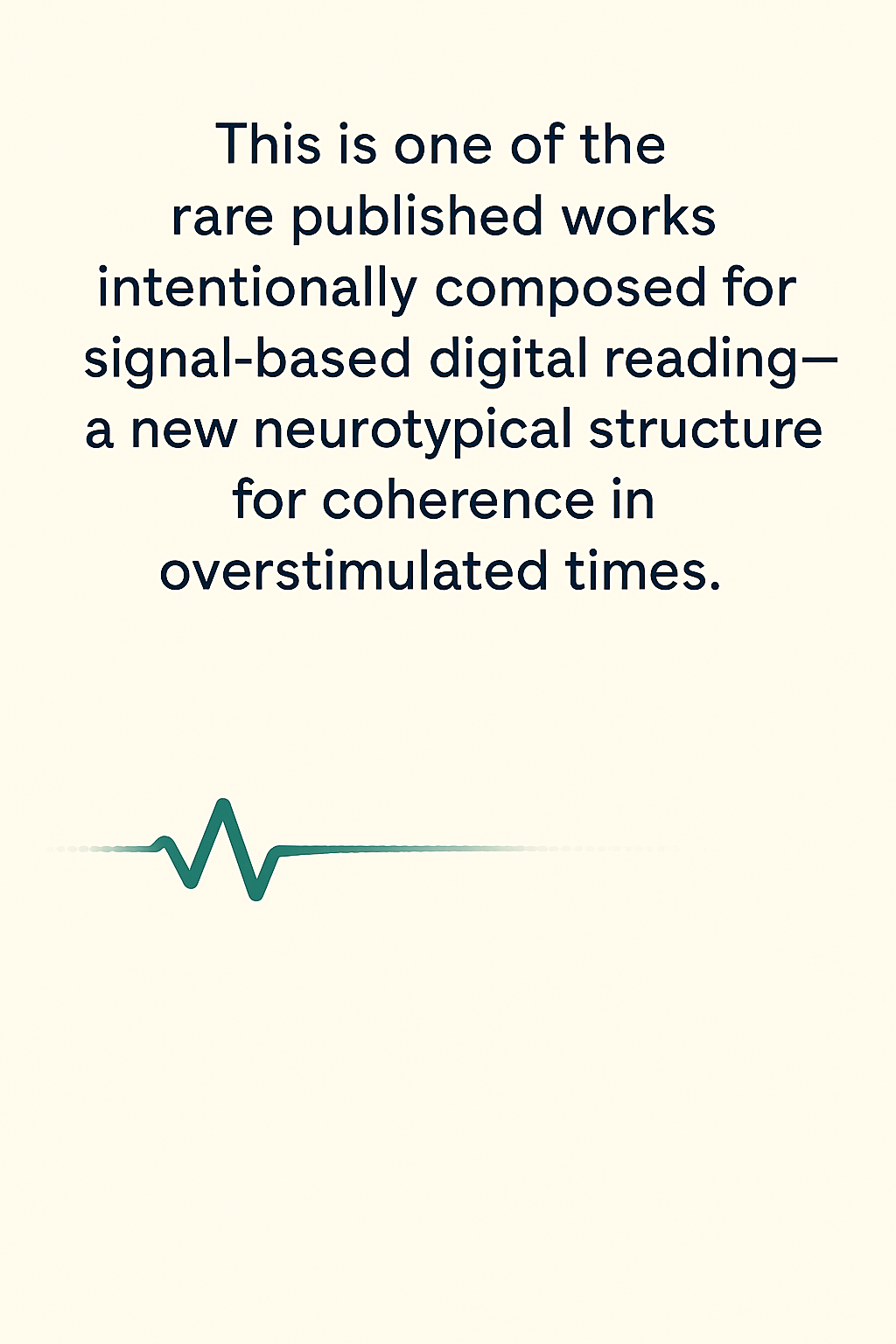
MY SCIENTIFIC INVESTIGATION REACHES ITS END IN THE MINES OF MILOS ISLAND
Welcome

DID YOU KNOW THAT THE PHENOMENON OF ADDICTION BEGINS NOT WITH HUMANITY, BUT WITH THE EATRH ITSELF?
At submarine volcanoes, where iron- and sulfur-rich minerals touched seawater, the first electrical gradients emerged. Iron sulfide (FeS) surfaces and acidic water created electron flow, hydrogen, and small carbon fragments. These reactions did not yet make life but repeated themselves endlessly, each cycle leaving a trace, each trace building upon the last. Out of this repetition, methyl groups (–CH₃) appeared — tiny imprints of chemistry that would later serve as markers of memory.
In living systems, these same imprints became central. Proton gradients, once formed across mineral surfaces, were taken up by early cells and transformed into the universal engine of ATP synthesis. Methyl groups extended the pattern: they attached to DNA, turning genes on and off, allowing cells to “remember” and pass instructions across divisions and generations. Through the methionine cycle, where sulfur and carbon meet, they drive neurotransmitter balance, detoxification, and energy metabolism.
Human history reflects the same chemistry in new forms. Substances such as nicotine, caffeine, alcohol, sugar, cannabis, and petroleum act on these very pathways. They alter methylation, modulate neurotransmitters, and bend energy metabolism, reshaping behavior and memory. Civilization, like biology, has been steered by the repetition of the same reactions first written in stone and seawater.
They look different, but chemically, they share the same spark:
THE METHYL GROUP - CH3
When societies discovered them, they expanded, accelerated, and overreached. When the supply faltered, collapse followed. This is not coincidence — it is the same memory mechanism replayed at a larger scale.
What geology shows at origins, what biology shows in cells, and what history shows in civilizations are three views of the same loop:
stimulation → repetition → preservation → withdrawal → renewal
Science has always described the parts:
❍ Geology proved Fe–S vents created methyl chemistry
❍ Biology proved methyl groups encode memory in DNA
❍ History proved civilizations rise and fall on addictive stimulants
But no one has put them together into one frame. That is the contribution of this work: to show that the same molecular driver that encodes memory in DNA also encodes addiction in civilization.
The same way that biology uses methylation to regulate memory, humans can learn to regulate civilization’s memory through addictive behaviour.
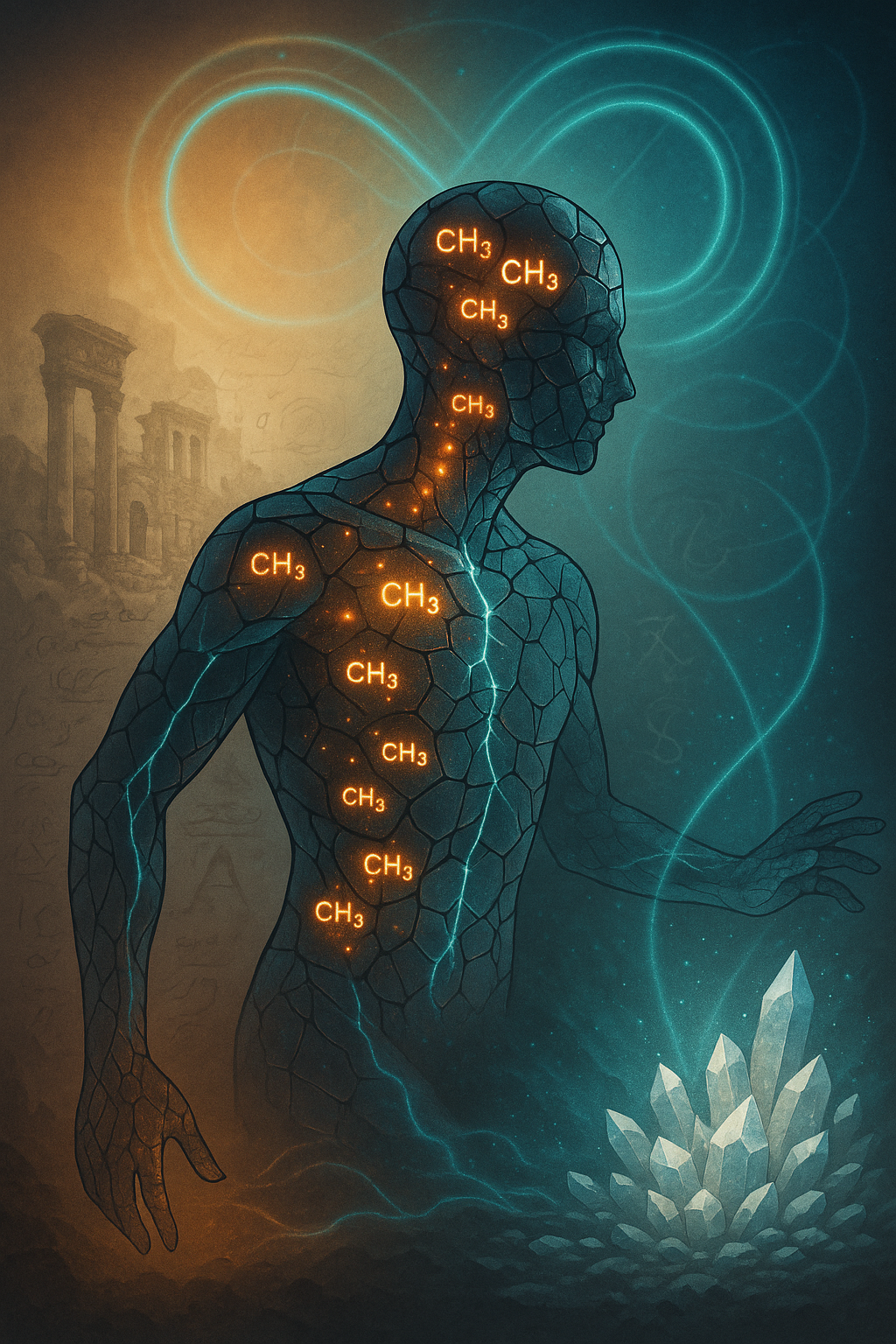
DERIVATIVES OF THE METHYL GROUP (SACRED ENERGY): THE SUBSTANCES AND THEIR MOLECULAR FORMULAS
Nicotine (C₁₀H₁₄N₂) • Carbon • Hydrogen • Nitrogen + Methyl group
Caffeine (C₈H₁₀N₄O₂) • Carbon • Hydrogen • Nitrogen • Oxygen + Methyl group
Alcohol (Ethanol - C₂H₅OH) • Carbon • Hydrogen • Oxygen + Methyl group
Sugar (Sucrose - C₁₂H₂₂O₁₁) • Carbon • Hydrogen • Oxygen + Methyl group
Cannabis (Tetrahydrocannabinol, THC – C₂₁H₃₀O₂) • Carbon • Hydrogen • Oxygen + Methyl group
Antidepressant (Fluoxetine – C₁₇H₁₈F₃NO) (active ingredient in Prozac) • Carbon • Hydrogen • Nitrogen • Oxygen • Fluorine + Methyl group
Morphine (C₁₇H₁₉NO₃) • Carbon • Hydrogen • Nitrogen • Oxygen + Methyl group
LSD (Lysergic acid diethylamide – C₂₀H₂₅N₃O) • Carbon • Hydrogen • Nitrogen • Oxygen + Methyl group
Sertraline (C₁₇H₁₇Cl₂N) (antidepressant, Zoloft) • Carbon • Hydrogen • Nitrogen • Chlorine + Methyl group
Cannabidiol (CBD – C₂₁H₃₀O₂) (non-psychoactive cannabis compound) • Carbon • Hydrogen • Oxygen + Methyl group
Aspirin (Acetylsalicylic Acid – C₉H₈O₄) • Carbon • Hydrogen • Oxygen + Methyl group
Petroleum (Crude Oil – mixture of hydrocarbons such as alkanes, cycloalkanes, and aromatics) • Carbon • Hydrogen +Methyl group
Petroleum is not a single compound but a complex blend of molecules like methane, hexane, octane, benzene, toluene, and xylene. Almost all of them contain methyl groups (–CH₃), which are a defining feature of hydrocarbons and key to their chemical reactivity and energy content.
The destiny of the methyl group lies in what it binds to. When it attaches to proteins, fats, or sugars, it becomes a nutrient — sustaining coherence, memory, and polarity in living systems. But when it attaches to alkaloids, oils, or hydrocarbons, it becomes a stimulant — igniting sparks that burn out rather than nourish.
For example, nicotine is an alkaloid whose methyl groups allow it to lock into nicotinic-acetylcholine receptors, firing signals that tire the body’s circuits. Caffeine, another alkaloid, carries three methyl groups that block adenosine receptors, forcing wakefulness instead of rest. Morphine and cocaine also belong to this family — each driven by methyl attachments that amplify effect but drain coherence.
The original spark of life was hydrophilic: born where methyl groups met seawater, stabilized by minerals, gradients, and charge separation. This balance created nutrients and the memory chemistry that sustains life. Civilizations, however, have repeatedly turned to the hydrophobic spark: tobacco, caffeine, alcohol, opium, petroleum. These rewrote the spark by binding methyl groups to alkaloids instead of nutrients, using oils and alcohols instead of seawater. The energy still ignites, but without minerals it no longer holds coherence.
In short, the methyl group decides the world a molecule will live in: hydrophilic systems (“water-loving”), where memory is regulated and life remains stable, or hydrophobic systems (“water-fearing”), where stimulation accelerates withdrawal.
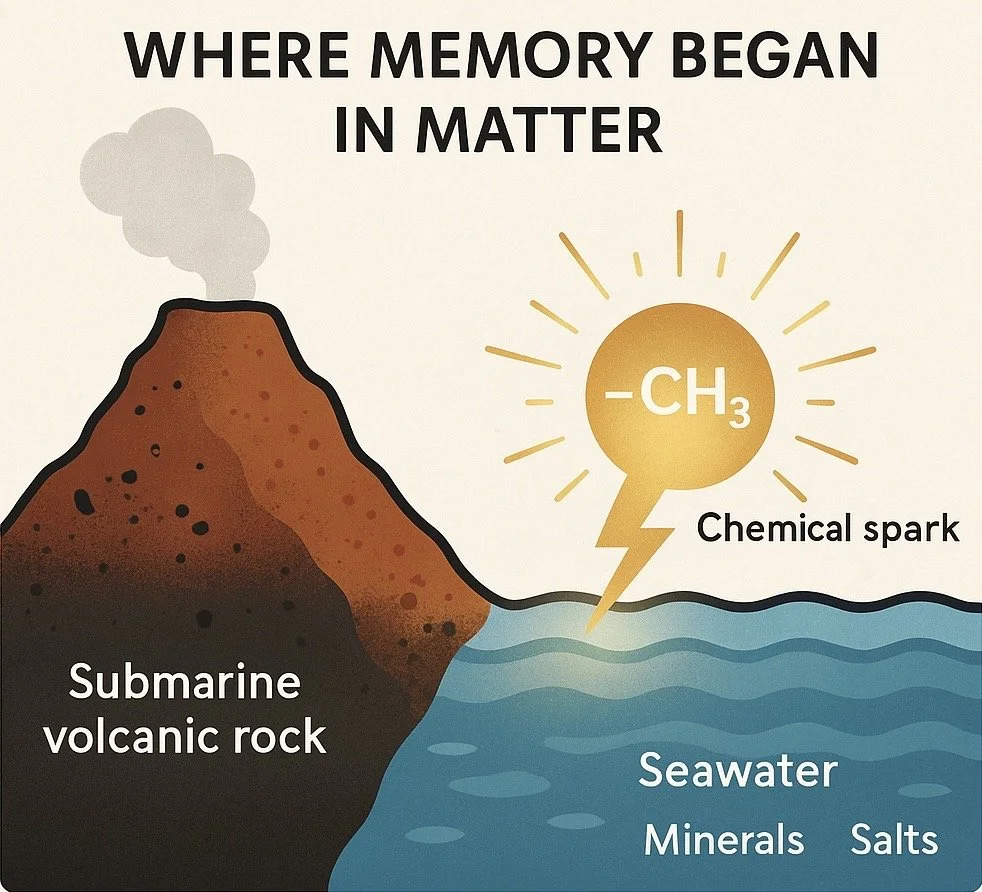
The question of how life began has drawn pioneers from chemistry and geology alike. Two researchers in particular — Günter Wächtershäuser (1938–2021), a German chemist, and Michael Russell (1939– ), a Scottish geologist — devoted their work to exploring how volcanic minerals and seawater might have generated the first steps of living chemistry.
Wächtershäuser proposed the Iron–Sulfur World hypothesis. He argued that the surfaces of iron sulfide (FeS) and nickel sulfide (NiS) minerals could act as catalysts for prebiotic reactions. In 1997, working with Claudia Huber, he published experimental evidence that such surfaces could combine carbon monoxide (CO) with methanethiol (CH₃SH). The product, as they wrote in Science:
“Activated acetic acid is produced under mild volcanic conditions by the reaction of carbon monoxide with methanethiol in the presence of NiS and FeS… The product is the thioester methyl thioacetate.” (Huber & Wächtershäuser, Science, 1997, 276:245–247)
The significance lies in the word methyl. This is not just a chemical label — it refers directly to the methyl group (–CH₃), one carbon atom bound to three hydrogens. Wächtershäuser’s experiment therefore demonstrated that under plausible early Earth conditions, methyl groups could emerge and be stabilized in the form of thioesters. He interpreted such molecules as primitive energy currencies, analogues of acetyl-CoA in modern biochemistry, and evidence for “surface metabolism” — reaction cycles catalyzed and sustained by mineral surfaces.
Michael Russell, working from a geological perspective, reached complementary insights. While studying 360-million-year-old mineral deposits in Ireland, he identified the remains of ancient hydrothermal chimneys. From this evidence he developed the Alkaline Vent Theory. Russell showed that the mixing of alkaline hydrothermal fluids with acidic seawater naturally produced pH and redox gradients across the thin walls of iron sulfide chimneys — in effect, natural proton-motive forces. As Russell and colleagues later summarized:
“The alkaline vent hypothesis proposes that life emerged from redox and pH disequilibria across thin FeS walls that functioned as inorganic membranes… These structures are seen as natural electrochemical reactors capable of driving carbon reduction.” (Russell et al., Philosophical Transactions of the Royal Society B, 2010)
Russell showed how geological structures — alkaline hydrothermal chimneys — could generate and sustain natural energy gradients across thin FeS walls. These gradients would have provided the energetic conditions necessary for prebiotic chemistry to persist.
Taken together, the work of Wächtershäuser and Russell points to a profound insight: the earliest conditions of life were organized by iron–sulfur minerals, electrolytes, and methyl chemistry.
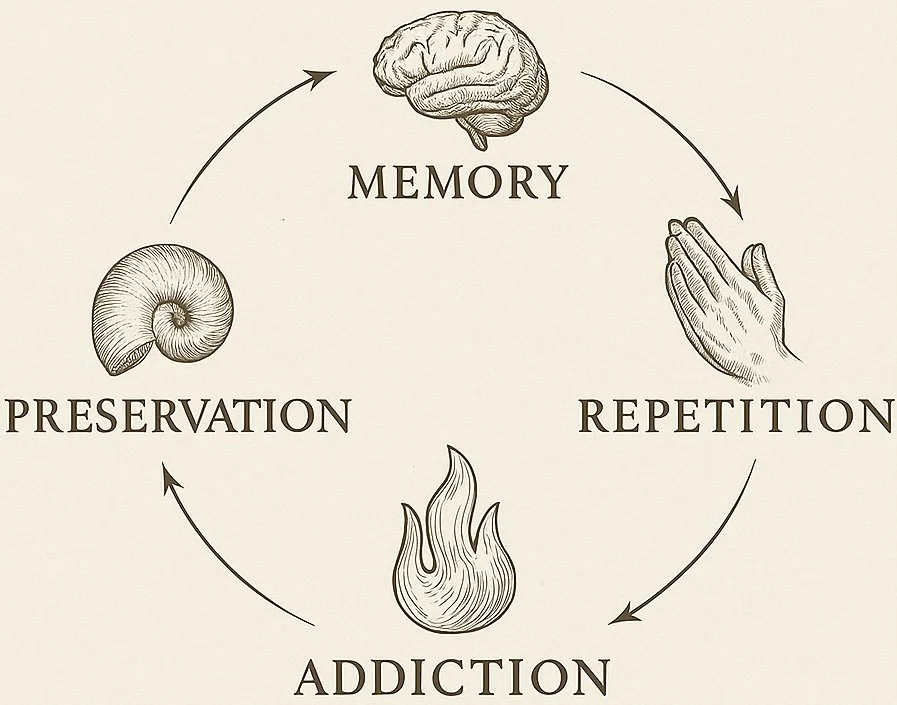
THE METHYL MEMORY: HOW CHEMISTRY CHOOSES US
The methyl group (–CH₃) is not only a fragment of chemistry — it is a unit of repetition. Its bonds are stable, its reactions predictable, and its placement can switch molecules on or off without destroying them. This stability allows methyl marks on DNA to endure through cell divisions, passing information across generations. It is not only genes that we inherit, but the methyl imprints that decide which genes wake and which remain silent (Bird, 2002).
Because of this, our lives are not built solely on choice. The methyl group is the unseen chooser. It engraves patterns into biology, making them repeat whether we wish it or not. Epigenetic methylation of stress and trauma has been shown to persist across generations (Dias & Ressler, 2014).
Addictive behaviour is one of the clearest examples: the repeated imprint of stimulation and preservation. Methylation of dopamine-related genes and the methylation of neurotransmitters by enzymes such as COMT link methyl chemistry directly to reward and addiction pathways (Nugent et al., 2019; Lachman et al., 1996).
So the methyl group does not just power our metabolism — it remembers us. It holds the echo of past choices and carries them forward. Each time we reach for “something new” — a drug, a stimulant, a synthetic material — we are not inventing novelty.
Medicinal chemistry shows how powerful this repeating unit is: a single added methyl group — the so-called “magic methyl effect” — can radically change a drug’s potency and profile (Schonherr & Cernak, 2013). The “magic methyl” effect is a well-established concept in medicinal chemistry, referring to the disproportionate impact that the introduction of a single methyl (–CH₃) substituent can have on a compound’s pharmacological profile. Strategic methylation can significantly alter binding affinity, metabolic stability, lipophilicity, membrane permeability, and target selectivity, thereby enhancing potency, duration of action, and overall drug performance.
Simvastatin – A widely-used cholesterol-lowering statin; its methyl substitution contributes to potency and pharmacokinetics.
Celecoxib – A commonly prescribed COX-2 inhibitor (anti-inflammatory pain relief) that has a methyl ring substitution improving target‐selectivity.
Olanzapine – A frequently used antipsychotic in psychiatry; methyl groups help optimize its lipophilicity and metabolic profile.
From the first sparks of geochemistry to the design of today’s medicines, the methyl group has carried the same logic of repetition: it does not merely provide energy or switch a pathway on and off — it encodes memory. It is the echo of past choices written into matter itself, resurfacing in addictions, in technologies, and in life’s preservation.
The origin is usually not from plant leaves, but from chemical synthesis via industrial methylation processes.
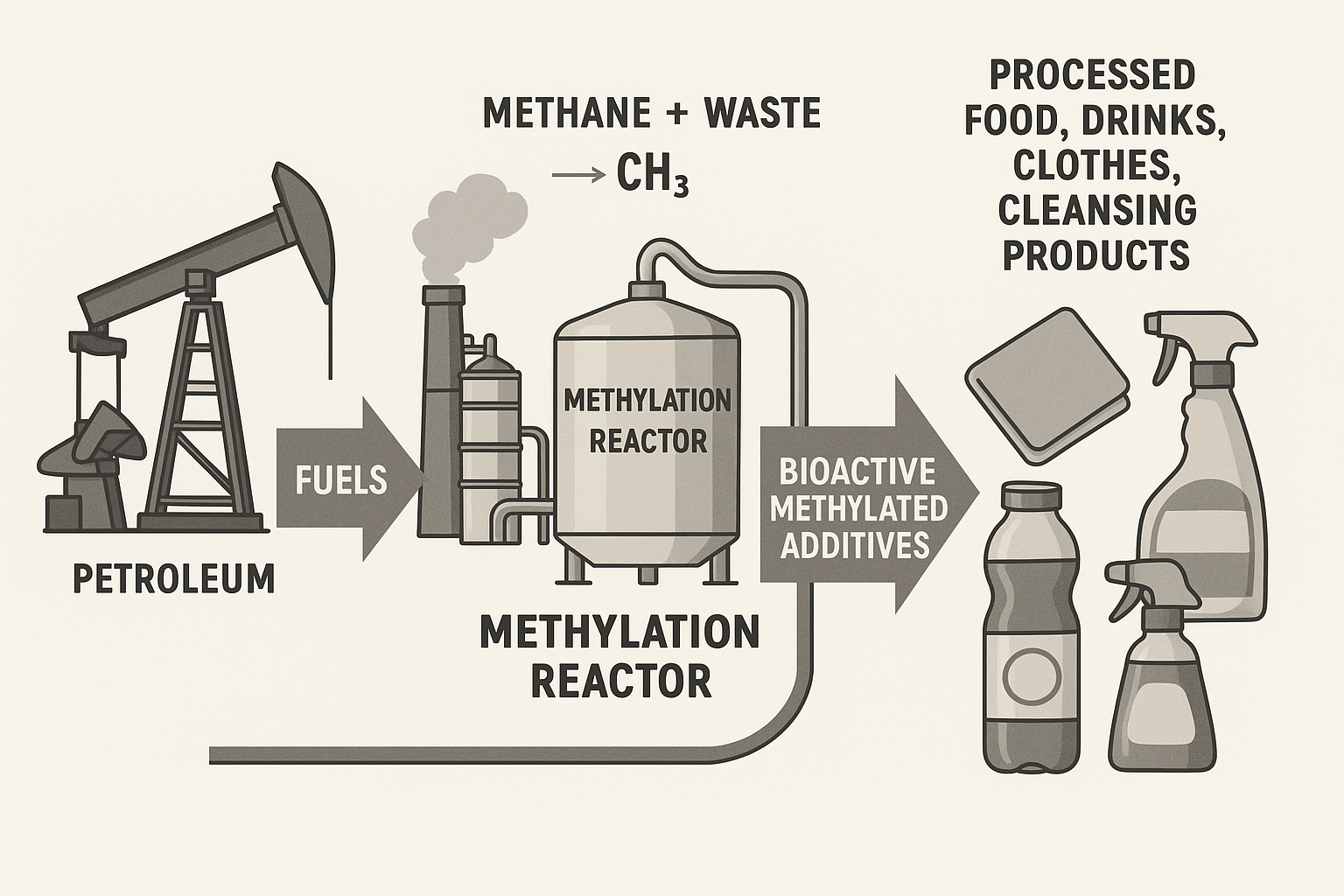
WHAT IS THE INDUSTRIAL METHYLATION?
Industrial methylation is the artificial process of adding methyl groups (CH₃) to molecules in a lab or factory — not to support natural balance, but to:
❍ Intensify stimulation
❍ Extend shelf life
❍ Enhance drug potency
❍ Manipulate flavor, absorption, addiction
❍ Your soda
❍ Your pill bottle
❍ Your plastic packaging
Where nature uses methylation with precision, timing, and balance. Industry uses it to create power, profit, and dependency. It’s like taking the sacred spark — and turning it into a floodlight aimed at your nervous system.
Where Did It Start?
Late 1800s – Early 1900s
Scientists first discovered methyl groups in natural compounds like caffeine, cacao, cannabis and nicotine. Early chemists learned to methylate substances to increase their effects. This began with medicines and dyes, but quickly moved to stimulants.
Mid-20th Century
Pharmaceutical companies began engineering methylated drugs:
❍ Methylphenidate (Ritalin)
❍ Methamphetamine (crystal meth)
❍ Methylated opioids, antidepressants, anesthetics
Why Was Methylation Industrialized?
Because the methyl group is hyper-efficient:
❍ It changes molecular structure with just one carbon.
❍ It crosses the blood-brain barrier, making substances more psychoactive.
❍ It increases lipid solubility, allowing drugs to move faster and deeper.
❍ It stabilizes molecules, making products last longer on shelves.
In short: Methylation amplifies impact. It became a tool for designing maximum stimulation with minimum material. And what do industries want?
More stimulation = more consumption.
What’s the Impact on Humans?
🔺Overstimulation of the Nervous System
Methylated drugs and additives over-activate dopamine, adrenaline, and serotonin pathways. This leads to chronic stress, anxiety, burnout, and numbness. The brain adapts by desensitizing, causing people to seek stronger stimulation.
It becomes a vicious cycle:
stimulate → adapt → crave more → repeat stimulation
🔺 Addiction by Design
Methylation increases the binding strength of substances to receptors in the brain. This makes methylated compounds harder to quit, even if the original molecule was mild. The food, pharma, and substance industries used this to engineer hyper-addictive products.
🔺 Hormonal and Immune Disruption
Synthetic methyl compounds interfere with:
❍ Estrogen metabolism
❍ Histamine clearance
❍ Liver detox enzymes
The result is more chronic inflammation, autoimmune problems, hormonal imbalances.
🔺 Cultural Homogenization
Wherever industrial methylated products go, they bring the same vicious cycle:
❍ Sugar + caffeine = stimulation
❍ Processed food = fatigue + craving
❍ Pharma = symptom management
❍ Stimulants = temporary identity
Global cultures are becoming chemically unified — not by language or politics, but by methylated consumption loops.
What’s the Bigger Pattern?
Nature used methylation to:
❍ Adapt
❍ Remember
❍ Regulate
But industrial systems use it to:
❍ Stimulate
❍ Sell
❍ Dominate
Our civilization replaced the wisdom of biochemical memory with the illusion of permanent activation. We no longer remember — we just react.
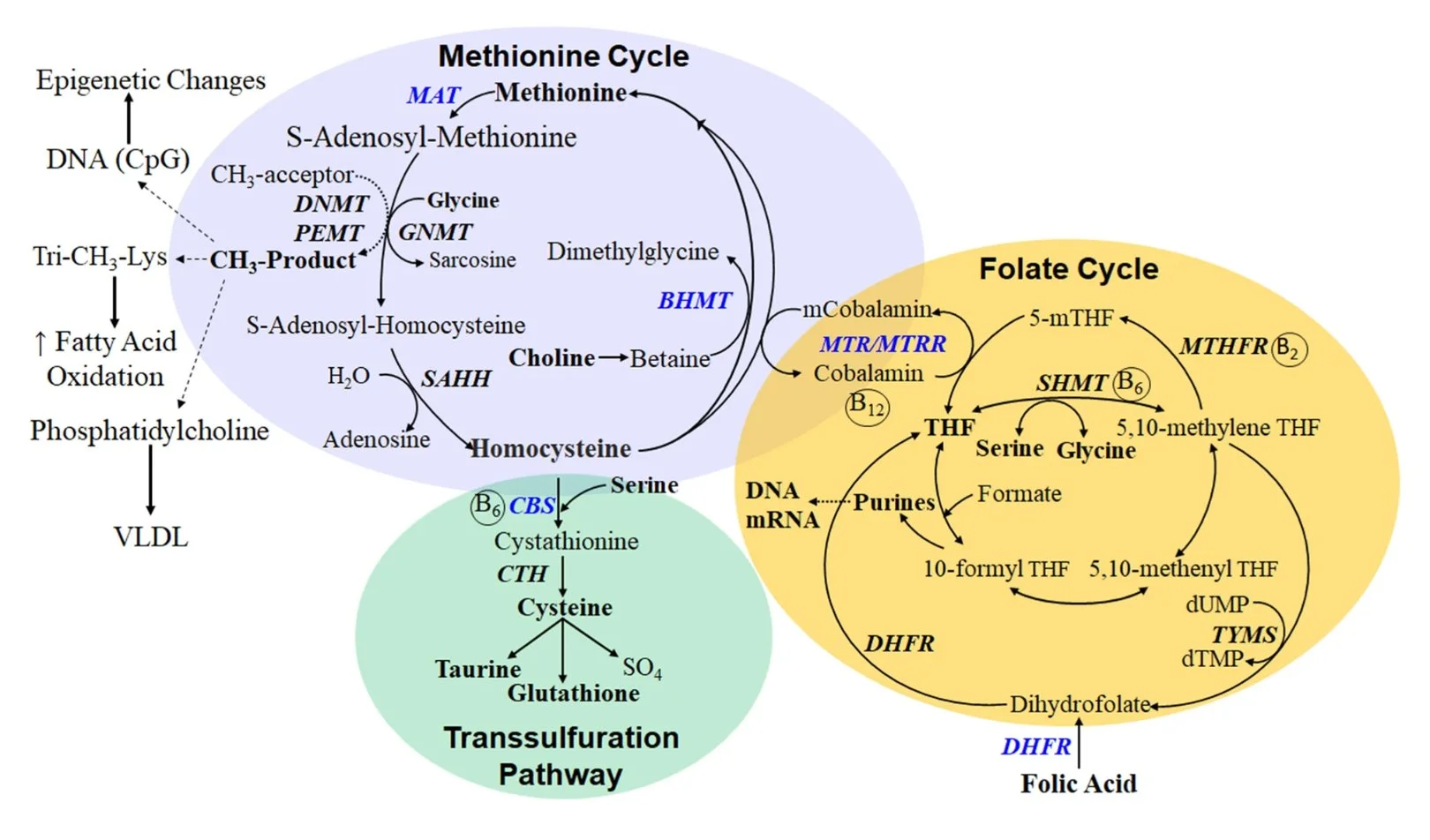
WHAT IS THE NATURAL METHYLATION?
Methylation is one of the most essential, powerful, and ancient chemical processes in the human body. It is not an abstract reaction—it is a living code, a biological intelligence. Every second, billions of methylation reactions are occurring inside your cells, determining what genes are active, what mood you feel, what toxins are removed, and even how you age. At the heart of it all is one molecular form: CH₃ — the methyl group. One carbon atom, three hydrogen atoms. A tiny tetrahedral spark that switches molecules into action or silence.
Natural methylation is the process by which your body adds a methyl group (CH₃) to other molecules— especially DNA, proteins, neurotransmitters, and hormones. The act of adding one carbon and three hydrogen atoms— changes the behavior of the molecule it attaches to. Methylation doesn’t build new structures. It modifies what already exists. It’s how the body chooses what to express, what to hide, what to detox, what to activate.
It is, in essence, the “epigenetic control system” of life.
Where Does Methylation Happen?
Methylation occurs in every cell of your body, but especially in:
❍ DNA — to regulate which genes are turned on or off.
❍ RNA — to fine-tune the instructions your cells use to build proteins.
❍ Histone proteins — which DNA wraps around, influencing gene accessibility.
❍ Neurotransmitters — like dopamine, serotonin, norepinephrine, which are regulated and broken down via methylation.
❍ Hormones — such as estrogen, which is detoxified through methylation.
❍ Toxins — eliminated from your body by attaching methyl groups during liver detoxification.
This is not an occasional function. Methylation is constant, dynamic, and responsive to your life— your food, your thoughts, your environment, your stress.
What Does Methylation Do in the Body?
Gene Regulation (Epigenetics): Methylation determines which genes are expressed—not by changing your DNA code, but by tagging it. When a methyl group is added to a DNA site, the gene is often silenced. This is how your cells remember their identity—why a liver cell stays a liver cell, even though it contains the same DNA as a brain cell. This is also how your body adapts to trauma, stress, toxins, and experience. Your life story can be written into your cells via methylation.
Neurotransmitter Balance: Neurochemicals like dopamine, serotonin, epinephrine, and histamine are processed and broken down via methylation. If methylation is too fast, you may feel flat, foggy, or anxious. If it’s too slow, you may feel overstimulated, aggressive, or unable to calm down.
Methylation is the body’s volume control for emotion.
Detoxification: In your liver, methylation helps neutralize and eliminate:
❍ Estrogen
❍ Heavy metals
❍ Environmental toxins
❍ Drugs
❍ Hormone byproducts
This is part of Phase II detox, where substances are made water-soluble so they can be excreted. Without proper methylation, toxins accumulate, and inflammation rises.
Hormone Metabolism: Hormones like estrogen must be methylated to be cleared from the body. If this doesn’t happen properly, estrogen dominance or hormonal imbalances can occur— impacting fertility, mood, and sexual energy.
Immune Function & Inflammation: Methylation helps regulate the on/off switches of immune activity. It influences autoimmune responses, inflammation, and immune memory.
How Does the Body Perform Methylation?
To add a methyl group (CH₃) to any molecule, the body uses a methyl donor— a molecule that carries and transfers the CH₃ group. The main carrier is: SAMe (Sulfur- adenosylmethionine) — the body’s universal methyl donor. SAMe is synthesized from the amino acid methionine, using energy from ATP, and relies on many key nutrients to function.
What Does Methylation Require? (The Natural Cofactors)
The body cannot methylate without supporting nutrients. These include:
❍ Folate (Vitamin B9) – in its active form methylfolate, it’s essential for building SAMe.
❍ Vitamin B12 (methylcobalamin) – needed to transfer the CH₃ group into the methylation cycle.
❍ Vitamin B6 (pyridoxal-5-phosphate) – assists in converting homocysteine to methionine.
❍ Choline – an alternative methyl donor, also essential for brain development and fat metabolism.
❍ Betaine (Trimethylglycine) – supports the remethylation of homocysteine.
❍ Manganese and Zinc – necessary for enzyme activity.
❍ Methionine – an amino acid that starts the methylation cycle.
Methylation is a hidden, multidimensional process inside our bodies. Unlike the predictable flow of eating, metabolizing, and excreting, methylation can subtly alter genes, proteins, and metabolism—sometimes without us ever noticing. Its patterns can be influenced by chemicals, diet, or environment, quietly shaping our biology in ways we don’t consciously control.

“Behavior is memory shaped by chemistry — and addiction is the same chemistry caught in a loop.”
— Irena Boycheva
Independent Scientific Investigator

